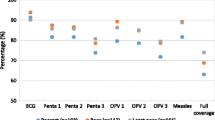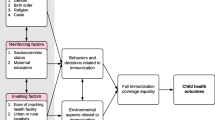Abstract
This article examines inequality of opportunity in immunization for Indian children. We also decompose the inequality by circumstances using the Shapley decomposition method. This method provides the contribution of each circumstance variable to the total inequality of opportunity. For this analysis, we use the District Level Health Survey for 2002–2004 and 2007–2008. The data sets provide information on immunization, household characteristics and availability of health care facilities in villages. Using this information we are able to understand the relative contributions of family background and supply-side circumstances to inequality of opportunity. We find that the household’s economic background, parental education and regional variations are the most important contributors to inequality of opportunity.
Abstract
Cet article analyse les inégalités d’opportunités d’immunisation chez les enfants Indiens. Nous désagrégeons les inégalités selon les circonstances en utilisant la méthode de décomposition de Shapley. Cette méthode permet à chaque variable de circonstance de contribuer au total des inégalités d’opportunités. Pour cette analyse, nous utilisons le sondage de santé des districts de 2002–2004 et 2007–2008. Les fichiers de données fournissent des informations sur le niveau d’immunisation, les caractéristiques des foyers et la disponibilité des centres de santé dans les villages. A l’aide de cette information, nous avons pu comprendre le rôle relatif du contexte familial et de l’offre des services de santé dans l’inégalité d’opportunités. Nous avons trouvé que le statut socio-économique du foyer, le niveau d’étude des parents et les variations régionales sont les variables qui contribuent le plus à l’inégalité d’opportunités.




Similar content being viewed by others
Notes
Foguel and Veloso (2014) extended the HOI by incorporating parental decision not to send children to preschool into coverage rate. However, in the present article we estimate the HOI proposed by Barros et al (2009).
The DLHS-3 does not cover the state of Nagaland. In order to maintain parity, we have excluded Nagaland from the DLHS-2 for the present analysis.
This information is based on a questionnaire for ‘ever-married’ women in the age group 15–49 years. In the present analysis, we concentrate on ever-married women to analyse immunization coverage.
We ignore the household-level correlations as the proportion of women reporting information on two children is very small. Moreover, the results remain qualitatively the same even if we use data only on the last surviving child.
References
Asadullah, M.N. and Yalonetzky, G. (2012) Inequality of educational opportunity in India: Changes over time and across states. World Development. 40 (6): 1151–1163.
Barros, R.P., Ferreira, F., Vega, J.M. and Chanduvi, J.S. (2009) Measuring Inequality of Opportunities in Latin America and the Caribbean. Washington DC: The World Bank.
Bourguignon, F., Ferreira, F.H.G. and Menéndez, M. (2007) Inequality of opportunity in Brazil. Review of Income and Wealth. 53 (4): 585–618.
Burton, A. et al. (2009) WHO and UNICEF estimates of national infant immunization coverage: Methods and processes. Bulletin of the World Health Organization. 87 (7): 535–541.
Checchi, D. and Peragine, V. (2010) Inequality of opportunity in Italy. Journal of Economic Inequality 8 (4): 429–450.
Ferreira, F.H.G. and Gignoux, J. (2008) The Measurement of Inequality of Opportunity: Theory and an Application to Latin America. Policy Research Working Paper 4659. The World Bank, http://dx.doi.org/10.1596/1813-9450-4659.
Ferriera, F. and Gignoux, J. (2011) The measurement of inequality of opportunity: Theory and an application to Latin America. Review of Income and Wealth. 57 (4): 622–657.
Filmer, D. and Pritchett, L. (2001) Estimating wealth effects without expenditure data – Or tears: An application to educational enrollments in states of India. Demography 38 (1): 115–132.
Foguel, M.N. and Veloso, F.A. (2014) Inequality of opportunity in daycare and preschool services in Brazil. Journal of Economic Inequality 12 (2): 191–220.
Government of India (2013) National Rural Health Mission: Meeting People’s Health Needs in Rural Areas. Ministry of Health and Family Welfare, http://nrhm.gov.in/nhm/nrhm/nrhm-framework-for-implementation.html.
IIPS (2006) District Level Household Survey (DLHS-2), 2002–04: India. Mumbai, India: IIPS.
IIPS (2010) District Level Household and Facility Survey (DLHS-3), 2007–08: India: Key Indicators: States and Districts. Mumbai, India: IIPS.
Kolenikov, S. and Shorrocks, A.F. (2005) A decomposition analysis of regional poverty in Russia. Review of Development Economics. 9 (1): 25–46.
Roemer, J. (1998) Equality of Opportunity. USA: Harvard University Press.
Shorrocks, A.F. (1999) Decomposition Procedures for Distributional Analysis: a Unified Framework Based on the Shapley Value. Unpublished Manuscript. Department of Economics, University of Essex.
Shorrocks, A.F. (2013) Decomposition procedures for distributional analysis: A unified framework based on the Shapley value. Journal of Economic Inequality 11 (1): 99–126.
Singh, A. (2011) Inequality of opportunity in Indian children: The case of immunization and nutrition. Population Research Policy Review 30 (6): 861–883.
Singh, A. (2012) Inequality of opportunity in earnings and consumption expenditure: The case of Indian men. Review of Income and Wealth. 58 (1): 79–106.
Wan, G. and Zhou, Z. (2005) Income inequality in rural China: Regression-based decomposition using household data. Review of Development Economics. 9 (1): 107–120.
World Bank (2012) Inequality of Opportunity in Access to Basic Services among Egyptian Children. Report no. 70301-EG. Human Development Sector Unit. Middle East and North Africa Region. The World Bank.
WHO (2013) World Health Statistics – 2013, Geneva: WHO.
Acknowledgements
The author would like to thank the two referees for constructive comments and IRCC at IIT Bombay for providing financial support through the seed grant.
Author information
Authors and Affiliations
Rights and permissions
About this article
Cite this article
Pal, R. Decomposing Inequality of Opportunity in Immunization by Circumstances: Evidence from India. Eur J Dev Res 28, 431–446 (2016). https://doi.org/10.1057/ejdr.2015.11
Published:
Issue Date:
DOI: https://doi.org/10.1057/ejdr.2015.11




